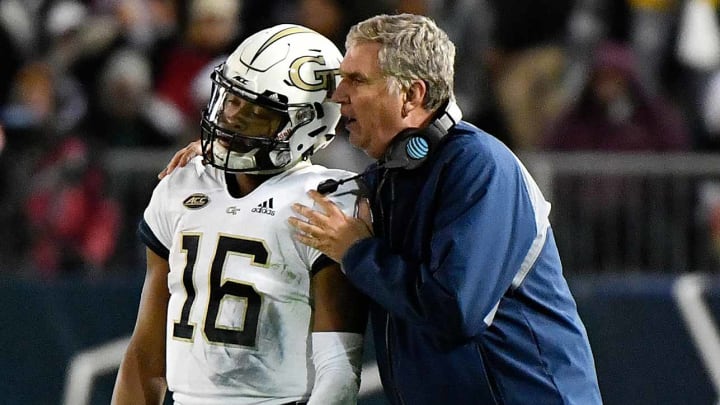What's Next for Georgia Tech After Paul Johnson? There's an Easy Way and a Hard Way Forward

Triple option football announced its arrival at Georgia Tech with a 9–4 season in 2008, the program’s best finish since 2000. Now that the mind behind it won’t be directing the Yellow Jackets beyond this season, the option may be phased out with less of a flourish.
Paul Johnson announced on Wednesday that he was stepping away after a 7–5 regular season, the 61-year-old’s eleventh as Georgia Tech’s head coach. Johnson’s exit plan had been the subject of years of speculation, but on the heels of a late-season surge by the Yellow Jackets, who were 3–4 in mid-October before ripping off a four-game winning streak in conference play, the public doom and gloom had cooled off. Still, Georgia Tech isn’t quite what it was in Johnson’s early years in Atlanta, when from 2008 to ’14, it never finished worse than fourth in its division and won the ACC Coastal three times: ’09, ’12 and ’14. Since then, it’s been a rocky few seasons: After a dismal 3–9 campaign in ’15, the Yellow Jackets jumped back to 9–4 in ’16, then missed a bowl last fall. As the program moves forward, it will have to consider how to best climb back to the top of the ACC Coastal—as well as how to handle any transition away from Johnson’s beloved triple-option offense and the players who were recruited to run it.
This fall, Georgia Tech had the top rushing offense in the FBS, edging out its triple-option counterparts at Army (No. 2) and Navy (No. 3) with 334.9 rushing yards per game, a total of 4,019 yards on the ground and an average of 5.7 per carry. That’s close to business as usual, but the 2018 team featured the worst defense of Johnson’s tenure, even after Johnson hired Nate Woody from Appalachian State last offseason to replace the much-maligned Ted Roof as that unit’s coordinator. The new staff, whoever it might comprise, will need to work first and foremost to clean up that side of the ball. In the ACC’s more wide-open division, Georgia Tech should have a consistently manageable path to the conference championship game—this year, all it would have taken was one more conference win—but recently, getting there has been a tall task.
DELLENGER: The Past, Present and Future of the Triple Option
Transitioning to the triple-option is a recruiting and coaching challenge—although Johnson managed to make it look something approaching easy 10 years ago. Option linemen give up 10 to 20 pounds and maybe a few inches on their counterparts in traditional offenses, while receivers aren’t promised more than a handful of pass attempts per game and quarterbacks run the risk of taking too many hits.
Transitioning away from the triple-option completely is an even more complicated beast. Just look at what happened when Georgia Southern, where Johnson ran the flexbone from 1997 to 2001 before he was hired away by Navy, tried to transition away from its trademark scheme under Brian VanGorder in 2006. The Eagles went 3–8 that year, VanGorder resigned, and by 2010 they had returned to a triple-option offense. Going that route would demand a revamping of the entire offensive roster, from skill positions to the line, and it would demand patience during the shakiest moments of the personnel changeover. The floating of current Chargers offensive coordinator Ken Whisenhunt, a Georgia Tech alum, among the early leading candidates for the job by ESPN’s Adam Rittenberg indicates that the school is at least considering it. Whisenhunt has coached in the NFL ever since he spent two years on the Vanderbilt staff in the mid-’90s, and it wouldn’t be surprising to see a Herm Edwards-esque level of skepticism accompany his return to the college ranks.
There’s a much easier way, however—and it doesn’t have to be as simple as replacing Johnson with another coach from one of the academies or another program that runs an offense steeped in option principles. Instead, Georgia Tech can look at any number of offensive minds who run spread schemes that incorporate plenty of option elements, which has become the norm around the college game and has gradually infiltrated the NFL as well. No matter who they hire, it would be an adjustment for the Yellow Jackets to pass the ball more than 10 times a game, but with the right resourceful mind pulling the strings, any number of creative college coaches could oversee a transition not nearly as jarring as pivoting to a pro-style scheme.
If Johnson never returns to the sidelines, his departure from the coaching ranks will mark a major shift in college football’s offensive landscape. His flexbone scheme lives on at programs like Navy, Army and Georgia Southern where his former assistants call the shots, but innumerable spread teams have adopted those principles for their offenses run out of the shotgun and flourished. Still, no Power 5 team is committed to the option the way Georgia Tech has been over the past decade. Johnson’s 196–103 career coaching record (a .656 winning percentage) tells you all you need to know about the triple option. When run properly, it can trip up the game’s best teams—look no further than the Citadel’s even first half against Alabama earlier this month, or the overtime scare Army put into Oklahoma in September—but those upset bids only tell a fraction of the story. If Johnson’s career proves anything, it’s that the triple option can be a path to sustained success instead of merely an equalizer. In its upcoming search for a new leader, Georgia Tech will reveal how committed it is to switching paths.

Staff writer Joan Niesen returned to SI in 2014 after first coming to SI as an intern while in graduate school. She covers college football and the NFL.